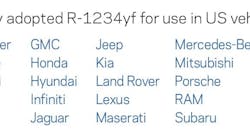This edition of Market Insights with Mike provides an in-depth look at the latest vehicle miles traveled (VMT) data in the United States and what the new trends in consumer and market behavior can mean for the auto care industry. VMT for March 2021 exceeded 300 billion miles—its highest level since Summer 2019.
While this increase in VMT is encouraging for the industry, everyone is anxious and wants to know when the pandemic will go away and how the aftermarket will perform this year. As much as the pandemic has thrown a wrench into cogs of the aftermarket, the hits just keep on coming. Looking to the future, it’s worth taking into account various external factors, including supply chain disruptions, the cost of materials, ongoing tariffs and more.
At Auto Care, we’ve talked about appropriate theme songs for our next in-person events. Willie Nelson is a popular choice in our group:
"On the road again; just can't wait to get on the road again..." Willie Nelson, "On the road again," copyright Sony/ATV Music Publishing LLC
Based on vehicle miles traveled (VMT) for March, the rest of the nation was singing along with Willie as monthly VMT reached its highest level since summer 2019 (Figure 1).
This was the first month since August 2019 that VMT exceeded 300 billion miles.
In the clear?
While this is encouraging for the industry, everyone is anxious and wants to know: when will the pandemic go away? How will the aftermarket perform this year? How bad was it last year?
Before looking to the future, supply chain and materials costs are worth a look. As much as the pandemic has thrown a wrench (sorry, couldn’t resist) into cogs of the aftermarket, the hits just keep on coming.
Microprocessor shortages have confounded new vehicle production. Lead times for microprocessors have been extending across other industries as well, including smart-lighting, as more and more consumer products become “smarter” (whether or not I need a smart dryer is another topic for another forum).
As some raw materials used in microprocessors are scarce, and as much of the infrastructure available to process the materials for use in commercial products (more on this here), this is further compounded by U.S.-China tariffs, more headaches for the Ever Given, increasing port traffic and related disruptions, and even a recent semiconductor facility fire in Japan. As reported, “at least 100 days” is anticipated “for production to normalize at the plant in northeast Japan” (Reuters).
In recent months, we have read of factory shutdowns due to microchip shortages, delaying production of popular vehicles like the Ford F-150, Ram 1500 pickup truck, and Jeep Cherokee (Autoweek). In Spring/Summer 2020, sales of used cars rose dramatically (see figure below) before retreating to pre-pandemic levels through the balance of 2020. This year, used car dealer sales have risen through February, and this trend may continue (note that private sales are not accounted for here), which may contribute to the increasing average age of vehicles (Figure 2).
Prices of metals and metal products have risen steadily over the past year. The chart below compares several broader industrial indicators from January 2020 through March 2021 as viewed through the “Trends Comparison” channel of TrendLens (Figure 3).
The prices of several industrial elements have risen dramatically throughout the past year. Figure 4 shows commodity trading prices for platinum and neodymium for the past 12 months.
With production delays, as well as the possibility for higher priced new vehicles, we may continue to see elevated demand for used vehicles. As many of these vehicles are likely to be out of warranty, that could bode well for the service side of the aftermarket.
Parting thoughts
As commuters return to hitting the road, they may look back to last year as the golden era of commuting: as reported by ArsTechnica, "the typical U.S. driver spent 26 hours stuck in traffic in 2020, down from an average of 99 hours in 2019. Only three cities saw an increase in traffic times: Santa Rosa, Calif.; Sarasota, Fla.; and Kaneohe, Hawaii." I’m guessing no one is moving out of Kaneohe because of the traffic.
As travelers get back on planes, rental car prices have jumped higher with the industry facing supply challenges as well. We’ll keep an eye on how rental car companies replenish their inventories and how ride/car-sharing services fare in the meantime.

